Select Language
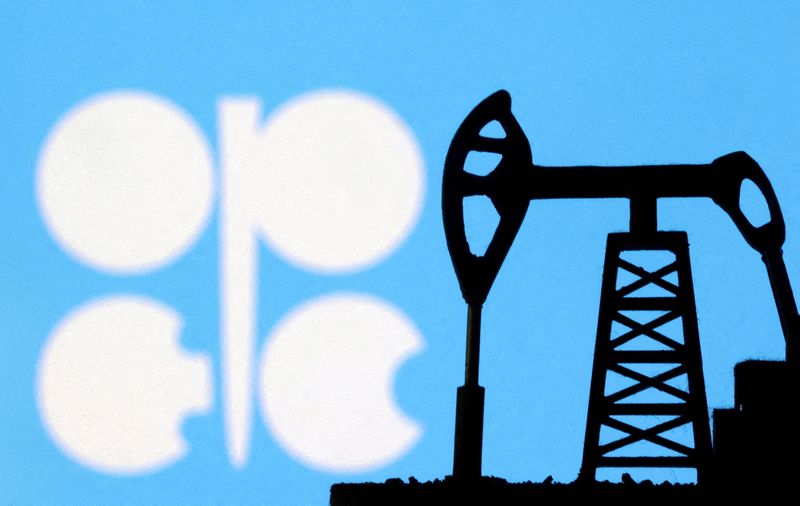
By Olesya Astakhova, Ahmad Ghaddar and Alex Lawler
LONDON/MOSCOW (Reuters) - Eight OPEC+ countries unexpectedly agreed on Thursday to advance their plan to phase out oil output cuts by increasing output by 411,000 barrels per day in May, a decision that prompted oil prices to extend earlier sharp losses.
Oil, which was already down over 4% on U.S. President Donald Trump’s announcement of tariffs on trading partners, extended declines after OPEC updated its plans in a statement, with Brent crude dropping over 6% to below $70 a barrel.
Eight members of OPEC+, which includes the Organization of the Petroleum Exporting Countries and allies led by Russia, had been scheduled to raise output by 135,000 barrels per day in May as part of a plan to gradually unwind their most recent layer of output cuts.
But after a meeting of the eight countries held online on Thursday, the group announced it would boost output by 411,000 bpd in May. OPEC cited "continuing healthy market fundamentals and the positive market outlook."
"This comprises the increment originally planned for May in addition to two monthly increments," OPEC said in a statement referring to the volume. "The gradual increases may be paused or reversed subject to evolving market conditions."
The increase will reduce fears arising from any disruption to Iranian supply as Trump restores maximum pressure on Tehran, also an OPEC member. The U.S. President, who has called on OPEC to lower prices since starting his second term, may visit Saudi Arabia as soon as next month.
The May hike is the next increment of a plan agreed by Russia, Saudi Arabia, UAE, Kuwait, Iraq, Algeria, Kazakhstan and Oman to gradually unwind their most recent output cut of 2.2 million bpd, which came into effect this month.
OPEC+ also has 3.65 million bpd of other output cuts in place until the end of next year to support the market. The total of 5.85 million bpd is equal to about 5.7% of global supply.
FOCUS ON COMPLIANCE
The decision on Thursday partly reflects OPEC+ leaders’ wish to improve compliance with production quotas, analysts said.
"OPEC+ focus is on compliance and this decision forces the laggards to step up compliance," said Amrita Sen, co-founder of Energy Aspects.
Record output in Kazakhstan has angered several other members of the group, including top producer Saudi Arabia, sources have told Reuters. OPEC+ is urging the Central Asian country, among other members, to make further cuts to compensate for excess production.
Kazakhstan has been producing oil well above the targets agreed with OPEC+ in recent months. OPEC data also shows some other OPEC+ nations such as the United Arab Emirates, Nigeria and Gabon pumping above their quotas, but by far smaller amounts.
Production in Kazakhstan could drop this month and exports could decline after Russia ordered to shut some export capacity on the CPC pipeline, the main evacuation route for oil in Kazakhstan produced by oil majors such as U.S. Chevron (NYSE:CVX) and Exxon Mobil (NYSE:XOM).
The eight OPEC+ countries will meet on May 5 to decide on June output, OPEC’s statement said.
(This story has been refiled to fix the spelling of ‘Iranian’ in paragraph 6)
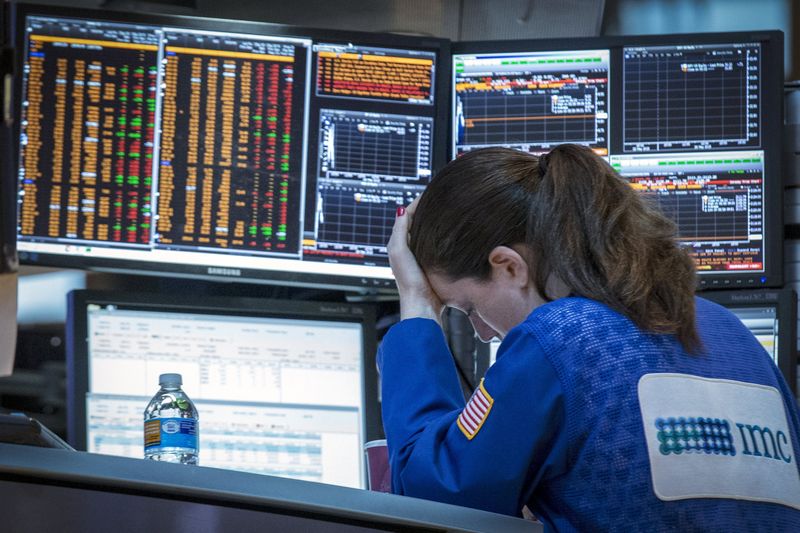
The S&P 500 suffered its biggest one-day slumped since 2020 after U.S. President Donald Trump announced comprehensive trade tariffs, prompting fears of an all-out trade war that could result in a global recession.
At 4:00 p.m. ET (21:00 GMT), the blue-chip Dow Jones Industrial Average fell 1,679.4 points or 4%, the benchmark S&P 500 plunged by 4.8%, and the tech-heavy Nasdaq Composite fell 6%.
Trump tariffs prompt sharp selloff
President Trump announced sweeping new tariffs on Wednesday, imposing a 10% levy on all imports and significantly higher rates on countries deemed "bad actors."
China faces an additional 34% tariff on top of the 20% duties already in place. The European Union, Japan, and others will see tariffs ranging from 20% to 49%.
The broad tariffs take effect on April 5, with the country-specific hikes starting April 9.
Trump justified the tariffs by citing unfair trade practices and currency manipulation, asserting that these measures would rejuvenate American industries and reduce the national debt.
The "U.S. tariffs announcement was more hawkish than expected, particularly for Europe and China, with rates at 20% and ~54%," said analysts at Barclays, in a note. "Although there may be room for negotiation and many twists ahead, high tariffs and lingering uncertainty raise recession risk. Likely worse before getting better for stocks."
These tariff policies could see U.S. gross domestic product take a 10% hit in the second quarter of 2025, High Frequency Economics Chief Economist Carl Weinberg said in a note Thursday, potentially pushing the world’s largest economy into a recession after a predicted small contraction in the first quarter.
Weinberg estimated that tariffs would take $741 billion out of U.S. household real incomes or corporate profits, or more if fully accounting for all tariffs on aluminum, steel and non-exempt trade with Canada and Mexico.
UBS estimates that if these tariffs remain in place, real GDP could decline by 1.5 to 2 percentage points in 2025, while inflation could approach 5%.
The Swiss bank states that this scenario "has the potential to considerably worsen the growth inflation mix in the U.S. and the global economy in the coming year."
UBS analysts have set a near-term target of 5300 for the S&P 500, but warned in a note to clients that ongoing tariff uncertainty could drive the index below 5000.
Tariffs could hit Apple’s net profit by 14% - Jefferies
A number of the country’s major corporations have been hit hard by the tariffs news, with Apple (NASDAQ:AAPL), down 9%, a prime example given the hefty tariff on China - the base for much of Apple’s manufacturing.
Jefferies analysts warned that proposed U.S. tariffs on Chinese imports could significantly impact Apple’s profitability, estimating a potential 14% reduction in the company’s net profit for fiscal 2025 if it is not granted an exemption.
Shares of big sellers of imported goods were among the hardest hit. Five Below (NASDAQ:FIVE), Dollar Tree (NASDAQ:DLTR) and Gap (NYSE:GAP), for example, all suffered double digit percentage losses.
Retailers were also hit hard, with Nike (NYSE:NKE) and Walmart (NYSE:WMT) slumping after tariffs were imposed on major production hubs including Vietnam, Indonesia and China.
Tech shares also dropped in an overall risk-off mood, with Nvidia (NASDAQ:NVDA) and Tesla (NASDAQ:TSLA) both around more than 7% and 5% respectively.
Jobless claims drop; March jobs report looms
The number of Americans filing new applications for unemployment benefits fell last week, dropping 6,000 for the week ended March 29, pointing to continued labor market stability ahead of potential volatility from import tariffs.
Private payrolls, released on Wednesday, surprised to the upside, while JOLTS job openings disappointed earlier in the week, setting the scene for Friday’s nonfarm payrolls release.
That said, the Federal Reserve’s decision making as far as rate cuts are concerned could well now be determined by the impact on the U.S. economy from the trade tariffs.
Federal Reserve Governor Adriana Kugler said there were "upside risks" to inflation associated with Trump’s policy changes.
But these tariffs will likely dampen near-term growth, increase market volatility, and prompt the Federal Reserve to deliver significant rate cuts later this year, according to UBS.
The bank’s base case scenario assumes rate cuts of 75 to 100 basis points (bps) over the remainder of 2025.
(Peter Nurse, Ayushman Ojha and Scott Kanowsky contributed to this article.)
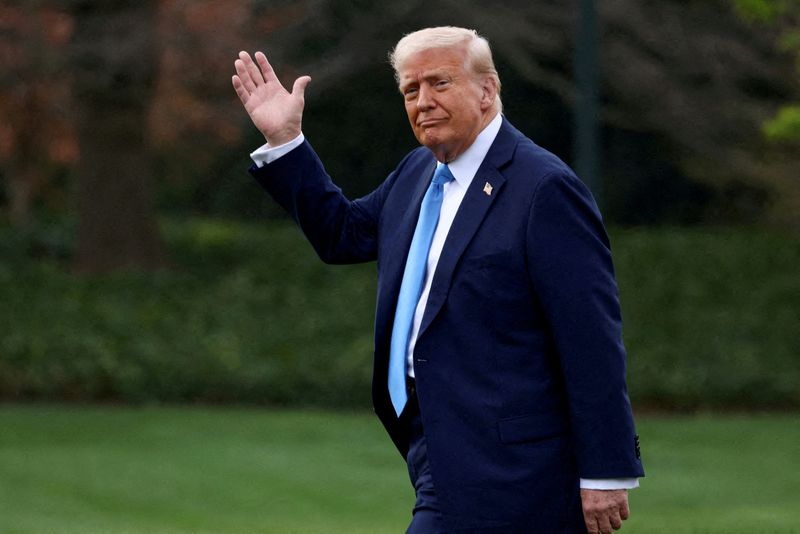
The sweeping new U.S. import tariffs announced by President Donald Trump have pushed the country’s average tariff rate to 22%, up from just 2.5% in 2024, according to Fitch Ratings.
That level of protectionism hasn’t been seen since around 1910, Fitch’s U.S. economic research head Olu Sonola said in a statement following the announcement.
"This is a game changer, not only for the U.S. economy but for the global economy," Sonola said. "Many countries will likely end up in a recession. You can throw most forecasts out the door, if this tariff rate stays on for an extended period of time."
Trump introduced a 10% baseline tariff on all imports, with significantly steeper rates for key trading partners, including 34% on China and 20% on the European Union. The administration also confirmed a 25% tariff on auto and auto parts. Speaking from the White House Rose Garden, Trump said the new tariffs would help restore critical manufacturing sectors to the U.S.
Over the coming months, the most immediate effect of the new levies is expected to be higher prices on thousands of consumer and business goods. That price pressure could curb demand both domestically and globally, adding to the risk of recession.
Tariff rates vary significantly by country—from 10% on UK imports to 49% on goods from Cambodia—suggesting uneven economic impacts. A broadening trade war would likely hit China especially hard, as it faces weak internal demand and would need to find new export markets.
If the U.S. economy begins to slide into recession under the weight of these tariffs, the repercussions would extend to many developing economies that rely on U.S. demand.
Financial markets reacted sharply, with stock futures falling and investors rotating into traditional safe havens including bonds, gold, and the Japanese yen.
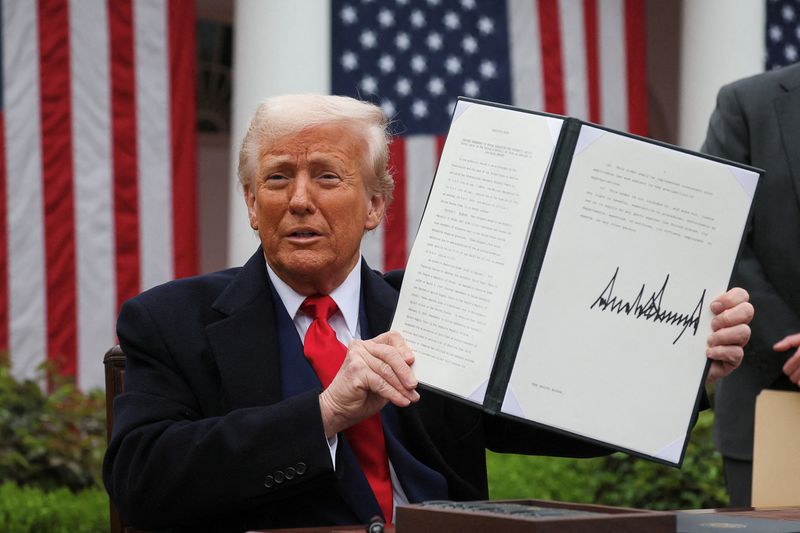
(This April 2 story has been corrected to delete Japanese PM Ishiba’s March 27 comment)
(Reuters) - U.S. President Donald Trump said he would impose a 10% baseline tariff on all imports to the United States and higher duties on some of the country’s biggest trading partners, drawing defiant responses from leaders and governments around the world.
Trump is not imposing his new 10% global tariff rate on goods from top trading partners Canada and Mexico while his previous order remains in place for up to 25% tariffs on many goods from the two countries over border control and fentanyl trafficking issues, the White House said in a fact sheet.
Here are some reactions from top officials and governments around the world:
EUROPEAN COMMISSION PRESIDENT URSULA VON DER LEYEN
"President Trump’s announcement of universal tariffs on the whole world, including the EU, is a major blow to the world economy."
"Uncertainty will spiral and trigger the rise of further protectionism. The consequences will be dire for millions of people around the globe."
"We are already finalising a first package of countermeasures in response to tariffs on steel. And we are now preparing for further countermeasures, to protect our interests and our businesses if negotiations fail."
CHINA COMMERCE MINISTRY
"China firmly opposes this and will take countermeasures to safeguard its own rights and interests."
"There are no winners in trade wars, and there is no way out for protectionism. China urges the U.S. to immediately lift unilateral tariffs and properly resolve differences with its trading partners through dialogue on an equal footing."
(This April 2 story has been corrected to delete Japanese PM Ishiba’s March 27 comment)
(Reuters) - U.S. President Donald Trump said he would impose a 10% baseline tariff on all imports to the United States and higher duties on some of the country’s biggest trading partners, drawing defiant responses from leaders and governments around the world.
Trump is not imposing his new 10% global tariff rate on goods from top trading partners Canada and Mexico while his previous order remains in place for up to 25% tariffs on many goods from the two countries over border control and fentanyl trafficking issues, the White House said in a fact sheet.
Here are some reactions from top officials and governments around the world:
EUROPEAN COMMISSION PRESIDENT URSULA VON DER LEYEN
"President Trump’s announcement of universal tariffs on the whole world, including the EU, is a major blow to the world economy."
"Uncertainty will spiral and trigger the rise of further protectionism. The consequences will be dire for millions of people around the globe."
"We are already finalising a first package of countermeasures in response to tariffs on steel. And we are now preparing for further countermeasures, to protect our interests and our businesses if negotiations fail."
CHINA COMMERCE MINISTRY
"China firmly opposes this and will take countermeasures to safeguard its own rights and interests."
"There are no winners in trade wars, and there is no way out for protectionism. China urges the U.S. to immediately lift unilateral tariffs and properly resolve differences with its trading partners through dialogue on an equal footing."
CANADIAN PRIME MINISTER MARK CARNEY
"(Trump) has preserved a number of important elements of our relationship, the commercial relationship between Canada and the United States. But the fentanyl tariffs still remain in place, as do the tariffs for steel and aluminum."
"We are going to fight these tariffs with countermeasures, we are going to protect our workers, and we are going to build the strongest economy in the G7."
BRAZILIAN FOREIGN MINISTRY
"The Brazilian government regrets the decision made by the North American government today, April 2, to impose additional tariffs of no more than 10% on all Brazilian exports to that country."
"The Brazilian government is evaluating all possible actions to ensure reciprocity in bilateral trade, including resorting to the World Trade Organization, in defense of legitimate national interests."
AUSTRALIAN PRIME MINISTER ANTHONY ALBANESE
"The (Trump) administration’s tariffs have no basis in logic and they go against the basis of our two nations’ partnership. This is not the act of a friend. Today’s decision will add to uncertainty in the global economy and it will push up costs for American households."
SOUTH KOREAN ACTING PRESIDENT HAN DUCK-SOO
"As the global trade war has become a reality, the government must pour all its capabilities to overcome the trade crisis."
NEW ZEALAND TRADE MINISTER TODD MCCLAY
"New Zealand’s interests are best served in a world where trade flows freely ... New Zealand’s bilateral relationship with the U.S. remains strong. We will be talking with the administration to get more information, and our exporters to better understand the impact this announcement will have."
SPANISH PRIME MINISTER PEDRO SANCHEZ
"Spain will protect its companies and workers and will continue to be committed to an open world."
SWEDISH PRIME MINISTER ULF KRISTERSSON
"We don’t want growing trade barriers. We don’t want a trade war ... We want to find our way back to a path of trade and cooperation together with the US, so that people in our countries can enjoy a better life."
SWISS PRESIDENT KARIN KELLER-SUTTER
"(The Federal Council) will quickly determine the next steps. The country’s long-term economic interests are paramount. Adherence to international law and free trade remain core values."
IRISH PRIME MINISTER MICHEAL MARTIN
"The decision by the U.S. tonight to impose 20% tariffs on imports from across the European Union is deeply regrettable. I strongly believe that tariffs benefit no one. My priority, and that of the government, is to protect Irish jobs and the Irish economy."
ITALIAN PRIME MINISTER GIORGIA MELONI
"We will do everything we can to work towards an agreement with the United States, with the goal of avoiding a trade war that would inevitably weaken the West in favor of other global players."
MANFRED WEBER, PRESIDENT OF THE EPP, LARGEST PARTY IN EUROPEAN PARLIAMENT
"To our American friends, today isn’t liberation day - it’s resentment day. Donald Trump’s tariffs don’t defend fair trade; they attack it out of fear and hurt both sides of the Atlantic. Europe stands united, ready to defend its interests, and open to fair, firm talks."
"We will only make U.S. imports more expensive if they take away our jobs. But we won’t raise tariffs if their goods help create higher-value jobs."

Asian stocks tumbled on Thursday, with Japan leading the declines, after U.S. President Donald Trump unveiled sweeping 10% tariffs on most imports and much higher reciprocal duties on some countries.
U.S. stock futures plummeted between 3% and 5% in early Asia hours.
Trump’s tariff hike sparks global trade concerns
President Trump on Wednesday announced a comprehensive overhaul of U.S. trade policy, instituting a universal 10% tariff on all imported goods, effective April 5, 2025.
Additionally, "reciprocal tariffs" targeting specific nations deemed to have significant trade barriers against U.S. products will take effect on April 9, 2025. These reciprocal tariffs are approximately half of the rates those countries impose on U.S. exports.
Under this new policy, China faces a combined tariff of 54%, with the new 34% surcharge atop an existing 20% levy.
Other notable tariffs include 24% on Japan, 20% on the European Union, 26% on India, 32% on Taiwan, and 46% on Vietnam.
Additionally, a 25% tariff on foreign-made automobiles and key auto parts was set to take effect on April 3, 2025.
The announcement could have dire implications for Asian economies, particularly export-driven nations like China, Japan, and Vietnam. The increased tariffs may lead to reduced export volumes to the U.S., potentially slowing economic growth in these countries.
Japan’s Nikkei hits 8-month low on tariff hit
Japan’s Nikkei 225 slumped as much as 4.7% on Thursday to its lowest level since early August 2024. It was trading 2.8% lower as of 02:08 GMT.
TOPIX index declined 3.1%.
“Since the US announced 25% auto tariffs will take effect from April 3, Japanese stocks have pulled back significantly and underperformed other major markets,” JPMorgan analysts said in a recent note.
Tariffs impacting Japan include item-specific duties, such as on autos and semiconductors, and reciprocal tariffs. The latter will have a smaller effect due to Japan’s low tax rates. However, a 25% tariff on autos—making up one-third of Japan’s exports to the U.S.—could have a major impact, according to JPMorgan.
JPMorgan analysts highlighted that major Japanese automakers, including Toyota (TYO:7203), Honda (TYO:7267), and Nissan (TYO:7201) would likely face higher costs, potential price increases, and weaker demand, weighing on earnings.
Asia stocks fall; China services PMI, Australia trade data in focus
China’s Shanghai Composite inched 0.2% lower, while the Shanghai Shenzhen CSI 300 index lost 0.4%.
Hong Kong’s Hang Seng index dropped 1.8%.
Data on Thursday showed that China’s services sector grew more than expected in March, with the Caixin Services PMI rising above expectations to 51.9.
In Australia, data showed that the trade balance sank to a more than four-year low in February, as exports fell sharply.
Australia’s S&P/ASX 200 index fell 1.1%.
Other regional markets were also lower. Singapore’s Straits Times Index lost 0.4%.
South Korea’s KOSPI declined 1.2%, while the Philippines’ PSEi Composite dropped 1%.
Futures for India’s Nifty 50 were 0.2% lower.
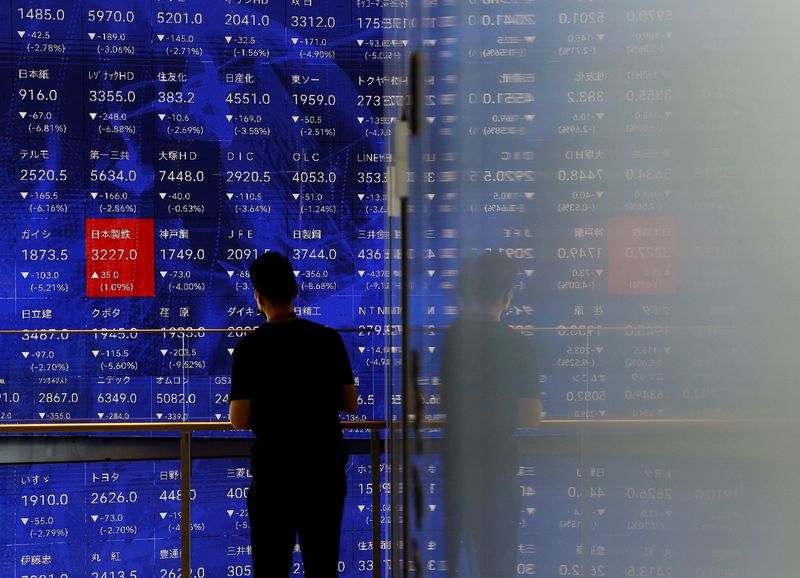
SINGAPORE (Reuters) -Stocks dived and investors scrambled to the safety of bonds, gold and the yen on Thursday as U.S. President Donald Trump unveiled a bigger-than-expected wall of tariffs around the world’s largest economy, upending trade and supply chains.
The high-flying tech sector was pummelled as manufacturing hubs in China and Taiwan faced new tariffs above 30%, bringing the total new levy to an eye-watering 54% on imports from China.
"The U.S. effective tariff rate on all imports look to be the highest level in over a century," said Citi’s global rates trading strategist, Ben Wiltshire.
Nasdaq futures tumbled 4% and in after-hours trade some $760 billion was wiped from the market value of Magnificent Seven technology leaders. Apple shares (NASDAQ:AAPL), hit hardest as the company makes iPhones in China, were down nearly 7%.
S&P 500 futures fell 3.3%, FTSE futures fell 1.8%, while European futures fell nearly 2%.[.N]
Gold hit a record high above $3,160 an ounce, and oil, a proxy for global growth, slumped more than 3% to put benchmark Brent futures at $72.56 a barrel. [GOL/][O/R]
In early trade in Tokyo, the Nikkei was down 3.9% at an eight-month low, with nearly every index member falling as shippers, banks, insurers and exporters copped a beating.
Benchmark 10-year Treasury yields shot down 14 basis points to a five-month low of 4.04% as investors braced for slower U.S. growth, while interest rate futures priced in a higher chance of interest rate cuts in the months ahead.
"The tariffs are so comprehensive and so much larger than we expected," said Jeanette Gerratty, chief economist at wealth advisory Robertson Stephens in the U.S. tech heartland of Menlo Park, California.
"People were talking earlier about whether clarity would boost the market. But now you have clarity, and no one likes what they see."
RISK TO GLOBAL TRADE
Trump announced a baseline 10% tariff on imports with far higher levies on some trading partners, particularly in Asia.
Besides China’s 34% tax, Japan got a 24% tariff, Vietnam 46% and South Korea 25%. The European Union was hit with a 20% levy.
South Korea’s Kospi fell 2%. Van Eck’s Vietnam ETF fell more than 8% in after-hours trade. Australian shares fell 2%.
Markets in Taiwan were closed for a holiday.
China’s yuan touched a two-month low in offshore trade, ahead of the onshore open. Ten-year Japanese government bond futures made their sharpest jump in eight months.
"The tariffs announced today lead to significant risk to global trade," said Zhiwei Zhang, chief economist at Pinpoint Asset Management in Hong Kong.
"Supply chains in East Asia face pressure in particular."
The U.S. dollar was higher against Asian currencies in rollercoaster currency trade, except against the safe-haven yen which rose to the strong side of 148 yen per dollar..
Trump also shut a loophole used to ship low-value packages from China, which is likely to hurt China’s giant online retailers.
Trading partners are expected to respond with countermeasures of their own that could lead to dramatically higher prices.
"The tariff rates unveiled this morning far exceed baseline expectations, and if they aren’t negotiated down promptly, expectations for a recession in the U.S. will rise dramatically," IG market analyst Tony Sycamore said.
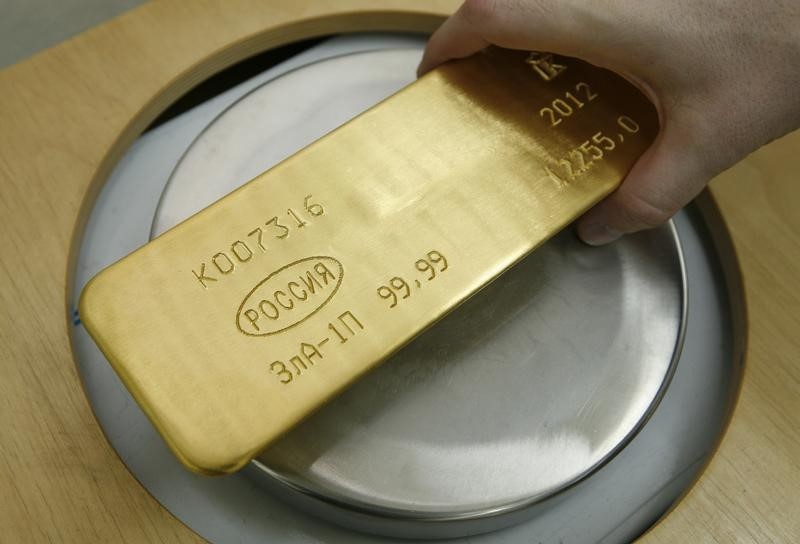
Gold prices rushed to a record high in early Asian trading on Thursday, benefiting from heightened safe haven demand after U.S. President Donald Trump imposed sweeping trade tariffs.
Trump’s tariffs, which will include universal tariffs and specific duties against at least 18 countries, stand to potentially upend global trade and also run the risk of denting U.S. and global economic growth.
This sparked a severe risk-off move in broader financial markets, pushing traders into safe havens such as gold and the Japanese yen. Gold also benefited from a decline in the dollar, although broader metal prices all retreated.
Spot gold hit a record high of $3,165.64 an ounce, while gold futures expiring in June hit a peak of $3,198.40/oz.
Trump imposes sweeping universal, reciprocal tariffs
Trump on Wednesday evening announced a 10% duty on all U.S. imports, and additional, reciprocal tariffs against major economies which will be equivalent to half of their duties on American goods.
China was by far the worst hit by this move, with total tariffs on the country, since Trump’s inauguration, now coming up to 54%.
The European Union will see 20% tariffs, while Vietnam, Taiwan, Japan, and India were slapped with tariffs between 24% and 46%.
Countries with lower duties on U.S. imports were subject to lower tariffs. These include Brazil, Chile, Australia, the UK, and Colombia- all of which will be subject to 10% tariffs.
The baseline tariffs will take effect from April 5, while Trump’s reciprocal tariffs will begin on April 9.
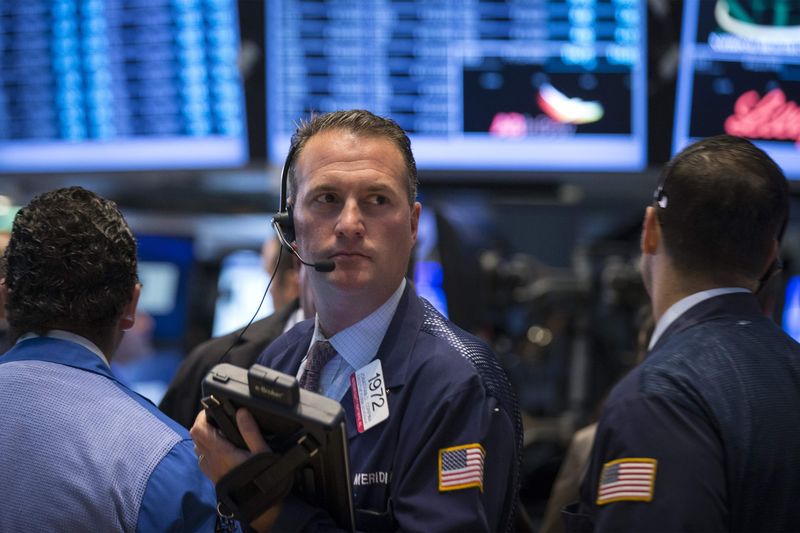
March saw the largest net selling of global stocks by hedge funds in the past 12 years, according to a note published by Goldman Sachs’ Prime Desk.
Heavy selling of risk assets was observed for four consecutive sessions at the end of the month and in 15 of the 21 sessions throughout the month, the report added.
Single stocks accounted for 94% of the selling, marking the largest monthly notional net selling on record.
Global equity markets have been on a downward trend, while the safe-haven XAU/USD reached a new record high this week. The S&P 500 is down 4.2% year-to-date.
Investors have increasing concerns over a potential global trade war leading to a recession, following U.S. President Donald Trump’s plan for tariffs that would essentially apply to all countries.
The President has termed Wednesday as "liberation day," as he prepares to announce his latest round of tariffs at the White House in the afternoon. Since taking office, Trump has announced and delayed plans to impose tariffs on foreign imports several times.
The uncertainty has caused unease in global stock markets, raised concerns among corporate executives and economists, and led to disputes with the U.S.’s largest trading partners.
"While high tariffs are likely to eventually hurt the US economy more than the rest of the world, global risk-off could still support the US Dollar Index Futures short-term," Bank of America FX strategists wrote in a client note.
As of now, no details regarding Wednesday’s plans have been disclosed. The President is scheduled to speak at 4pm ET, with White House officials stating that the implementation of the most comprehensive rewrite of U.S. trade policy would take effect immediately.

Asian stocks struggled for direction in range-bound trading on Wednesday as investors cautiously awaited key tariff announcements from U.S. President Donald Trump later in the global day.
U.S. stock futures were also muted in early Asia hours. Major U.S. stock indices closed higher on Tuesday with gains in technology shares.
Trump’s ’Liberation Day’ tariffs approach, markets watchful
Trump is set to impose reciprocal tariffs on a broad range of trading partners, on April 2. This initiative, referred to as "Liberation Day," will be followed by a 25% tariff on auto imports starting April 3.
Trump will unveil the new trade tariffs at 15:00 ET (19:00 GMT), and the measures will be effect immediately after the announcement, White House officials said on Tuesday.
Bessent told lawmakers on Tuesday that President Trump will impose the highest reciprocal tariffs on major trading partners on April 2, leaving the targeted countries to reduce the duties by meeting U.S. demands, according to CNBC.
Market participants worldwide are awaiting specific details about the tariffs.
Given the potential for these tariffs to disrupt global trade dynamics, investors were likely taking a wait-and-see approach, leading to subdued market movement.
Japan’s Nikkei 225 was largely muted on Wednesday, while TOPIX lost 0.6%.
China’s Shanghai Composite edged up 0.2%, while the Shanghai Shenzhen CSI 300 index was largely unchanged.
Hong Kong’s Hang Seng index gained 0.4%.
Singapore’s Straits Times Index fell 0.4%, while Australia’s S&P/ASX 200 ticked up 0.2%.
Futures for India’s Nifty 50 inched 0.2% higher.
S. Korea shares tick lower amid political instability
South Korea’s KOSPI inched 0.3% lower on Wednesday.
South Korea is facing political turmoil as the country’s Constitutional Court is set to review President Yoon’s impeachment over a controversial martial law order, with a decision on whether to remove or reinstate him expected on April 4.
Political instability often triggers concerns about economic disruption, which can result in cautious trading, capital outflows, and a flight to safer assets.
As South Korea is a major economy in the region, any significant instability could have a ripple effect on neighboring markets, particularly in trade-dependent countries.
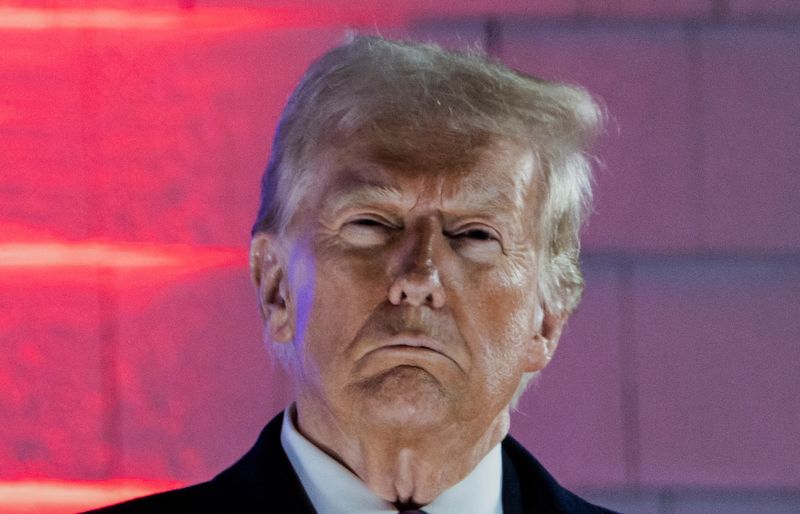
U.S. President Donald Trump will impose the highest possible reciprocal tariffs on major trading partners on April 2, and it will fall to the targeted countries to bring down the duties, Treasury Secretary Scott Bessent told lawmakers on Tuesday, according to CNBC.
Bessent said that Trump’s April 2 tariffs will serve more as a cap, and that the targeted countries can pass measures to meet U.S. demands and bring down the rate, CNBC’s Emily Wilkins reported, citing Congressman Kevin Hern.
The Trump administration said that the tariffs will be effective immediately, while Trump also recently warned that he will start with universal tariffs.
A report from the Washington Post said Trump was considering imposing duties on roughly 20% of imports coming into the country.
The U.S. President has repeatedly touted April 2 as “liberation day,” and is set to announce his most sweeping round of tariffs yet on Wednesday.
Trump is expected to impose tariffs based on the duties levied by other countries on U.S. imports, with any reduction in said duties set to result in lower U.S. tariffs.
A so-called “dirty 15” countries- which have large trade surpluses with the U.S., will be the most targeted, recent reports showed. China, Japan, India, Canada, Mexico, and Germany, are likely to face higher tariffs.
Trump’s 25% duties on automobiles are also set to take effect from April 2, while the President could also impose tariffs on other sectors such as select commodities, semiconductors, and pharmaceuticals.

